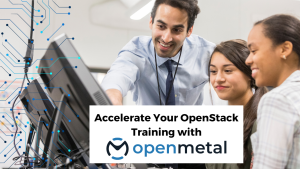Ready For Hands-On OpenStack Training?
OpenMetal is committed to making complex open source software such as OpenStack accessible to the open source community.
With OpenMetal there are two options for learners to choose from to get access to an OpenStack cloud.
Individual Learners
Can request a cloud trial (up to 8 hours) to experience the cloud platform.
Once you create an account, select “Trial” in the account portal.
Teachers and Institutions
Classes have priority access to a one week trial to facilitate hands-on training.
Schedule a complimentary consultation to discuss your class’ specific needs.
Institution versus Individual Trials
The purpose of individual trials is to provide IT professionals with a platform to experiment with small OpenStack projects, while institutional trials are designed to meet the needs of institutions requiring a cloud environment for a large number of users over a short period of time. In requests for individual trials, users may be waitlisted or denied.
Requests for institutional trials can come from various sources such as instructors, teaching assistants, department chairs, or college administration. Additionally, team leads who are seeking a suitable environment to train their engineers in OpenStack can also make requests for institutional trials. Once a class or department is approved, all students can be granted access to the assigned cloud. At the conclusion of each trial, all work completed is completely wiped, with no possibility of recovering data. For students engaging in a semester’s worth of OpenStack training or more complex assignments, a longer trial period is advantageous.
Institutional trials allow for ample time to work on advanced assignments and troubleshoot any issues that may arise during the process. It is important for instructors to know that limited resources are allocated to OpenMetal’s learner program, which is open globally, so all students in your class may not be able to access their own individual cloud in a timely manner.
Students from institutions that are part of our Educational Partners Program will have priority access to available trials over the general public.
How To Create An OpenStack Learning Environment In a Private OpenStack Cloud Core?
You can use an OpenMetal Cloud Core to create a learning environment for a class.
Step 1:
Deploy an OpenMetal On-demand OpenStack Cloud Core.
Be sure to select a cloud that’s large enough to support your classroom, you may want to give students individual or group projects within the clouds to allow them to set up their own OpenStack installation.
Step 2:
Create projects and users within the OpenStack cloud for each student/student group. Make sure that each project is allocated sufficient resources for your assignments. You can be lean if you are training your students to use OpenStack, but if you are training students to build their own OpenStack, each project will need a minimum of:
- 2 network interfaces
- 8GB main memory
- 40GB disk space
See documentation on creating Projects and Users within OpenStack.
Step 3:
Provide access to the cloud environment. Instructors can be shared users for projects alongside their students so they can log in and check on progress, provide guidance where needed, or check on completed work.
Step 4:
Assign projects and exercises.
OpenMetal has created an OpenStack Operator’s Manual that students can follow to begin their OpenStack journey.
There’s an abundance of resources available to learners on the OpenMetal Education and Training page to guide learners on their path to becoming OpenStack proficient. This page contains guides written by OpenMetal’s expert engineers, tutorial videos by tech gurus such as freeCodeCamp and LearnLinuxTV, as well as blogs and engineering notes.
Why use an OpenMetal private cloud core vs public cloud VMs?
Savings! Choosing OpenMetal over public cloud providers like AWS can easily save your institution over 50% and in some cases we’ve seen up to 88%. If you want to learn more about OpenMetal pricing vs AWS, check out our AWS Alternatives page.



































